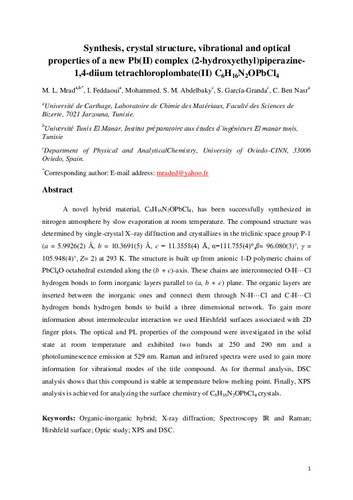Synthesis, crystal structure, vibrational and optical properties of a new Pb(II) complex (2-hydroxyethyl)piperazine-1,4-diium tetrachloroplombate(II) C6H16N2OPbCl4
Publication date:
Publisher version:
Citación:
Descripción física:
Abstract:
A novel hybrid material, C6H16N2OPbCl4, has been successfully synthesized in nitrogen atmosphere by slow evaporation at room temperature. The compound structure was determined by single-crystal X–ray diffraction and crystallizes in the triclinic space group P-1 (a = 5.9926(2) Å, b = 10.3691(5) Å, c = 11.3558(4) Å, α=111.755(4)°,β= 96.080(3)°, γ = 105.948(4)°, Z= 2) at 293 K. The structure is built up from anionic 1-D polymeric chains of PbCl4O octahedral extended along the (b + c)-axis. These chains are interconnected O-H···Cl hydrogen bonds to form inorganic layers parallel to (a, b + c) plane. The organic layers are inserted between the inorganic ones and connect them through N-H···Cl and C-H···Cl hydrogen bonds hydrogen bonds to build a three dimensional network. To gain more information about intermolecular interaction we used Hirshfeld surfaces associated with 2D finger plots. The optical and PL properties of the compound were investigated in the solid state at room temperature and exhibited two bands at 250 and 290 nm and a photoluminescence emission at 529 nm. Raman and infrared spectra were used to gain more information for vibrational modes of the title compound. As for thermal analysis, DSC analysis shows that this compound is stable at temperature below melting point. Finally, XPS analysis is achieved for analyzing the surface chemistry of C6H16N2OPbCl4 crystals.
A novel hybrid material, C6H16N2OPbCl4, has been successfully synthesized in nitrogen atmosphere by slow evaporation at room temperature. The compound structure was determined by single-crystal X–ray diffraction and crystallizes in the triclinic space group P-1 (a = 5.9926(2) Å, b = 10.3691(5) Å, c = 11.3558(4) Å, α=111.755(4)°,β= 96.080(3)°, γ = 105.948(4)°, Z= 2) at 293 K. The structure is built up from anionic 1-D polymeric chains of PbCl4O octahedral extended along the (b + c)-axis. These chains are interconnected O-H···Cl hydrogen bonds to form inorganic layers parallel to (a, b + c) plane. The organic layers are inserted between the inorganic ones and connect them through N-H···Cl and C-H···Cl hydrogen bonds hydrogen bonds to build a three dimensional network. To gain more information about intermolecular interaction we used Hirshfeld surfaces associated with 2D finger plots. The optical and PL properties of the compound were investigated in the solid state at room temperature and exhibited two bands at 250 and 290 nm and a photoluminescence emission at 529 nm. Raman and infrared spectra were used to gain more information for vibrational modes of the title compound. As for thermal analysis, DSC analysis shows that this compound is stable at temperature below melting point. Finally, XPS analysis is achieved for analyzing the surface chemistry of C6H16N2OPbCl4 crystals.
ISSN:
Patrocinado por:
Financial support from Spanish MINECO (MAT2016-78155-C2-1-R, MAT2013-40950-R, and FPI grant BES-2011-046948 to MSM.A.), Gobierno del Principado de Asturias (GRUPIN14-060), FEDER, and the Secretary of State for Scientific Research and Technology of Tunisia, are acknowledged.
Collections
- Artículos [37548]
- Investigaciones y Documentos OpenAIRE [8420]
- Química Física y Analítica [639]
Files in this item





